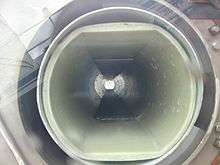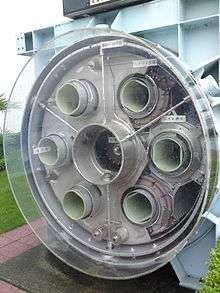Magnetohydrodynamic drive



A magnetohydrodynamic drive or MHD propulsor is a method for propelling vessels using only electric and magnetic fields with no moving parts, using magnetohydrodynamics.
The working principle involves electrification of the propellant (gas or water) which can then be directed by a magnetic field, pushing the vehicle in the opposite direction. Although some working prototypes exist, MHD drives remain impractical due to the slow speeds at which they generally propel a vessel and the large amount of energy needed to operate them.
Principle
Ship propulsion
An electric current is passed through seawater in the presence of an intense magnetic field, which interacts with the magnetic field of the current through the water. Functionally, the seawater is then the moving, conductive part of an electric motor. Pushing the water out the back accelerates the vehicle in the forward direction.
The physics equation describing this propelling force is Fmag = I (L × B) where L is the vector in the direction of the current 'I' and its length is the distance the current travels, B is the magnetic field, and × denotes the cross product.
MHD is attractive because it has no moving parts, which means that a good design might be silent, reliable, and efficient. Additionally, the MHD design eliminates many of the wear and friction pieces of the drivetrain with a directly driven propeller by an engine.
The major problem with MHD is that with current technologies, it is more expensive, and much slower, than a propeller driven by an engine. The extra expense is from the large generator that must be driven by an engine. Such a large generator is not required when an engine directly drives a propeller.
Spacecraft propulsion
A number of experimental methods of spacecraft propulsion are based on magnetohydrodynamic principles. In these the working fluid is usually a plasma or a thin cloud of ions. Some of the techniques include various kinds of ion thruster, the magnetoplasmadynamic thruster, and the variable specific impulse magnetoplasma rocket.
Prototypes
The first prototype of this kind of propulsion was built and tested in 1965 by Steward Way, a professor of mechanical engineering at the University of California, Santa Barbara. Way, on leave from his job at Westinghouse Electric, assigned his senior year undergraduate students to develop a submarine with this new propulsion system.[1] In 1991, another prototype, Yamato 1, was completed in Japan by the Ship & Ocean Foundation (later known as the Ocean Policy Research Foundation). The ship was first successfully propelled in Kobe harbour in June 1992. Yamato 1 is propelled by two MHD thrusters that ran without any moving parts.
Fiction
Oregon, a ship in the Oregon Files series of books by author Clive Cussler, has a magnetohydrodynamic drive. This allows the ship to turn very sharply and brake instantly, instead of gliding for a few miles. In Valhalla Rising, Clive Cussler writes the same drive into the powering of Captain Nemo's Nautilus.
The film adaptation of The Hunt for Red October popularized the magnetohydrodynamic drive as a "caterpillar drive" for submarines, an undetectable "silent drive" intended to achieve stealth in submarine warfare. In reality, the current traveling through the water would create gases and noise, and the magnetic fields would induce a detectable magnetic signature. In the novel from which the movie was adapted, the caterpillar that Red October used was actually a pumpjet of the so-called "tunnel drive" type. (The tunnels provided acoustic camouflage for the cavitation from the motors.)
In the Ben Bova novel, The Precipice, the ship where some of the action took place, Starpower 1, built to prove that exploration and mining of the Asteroid Belt was feasible and potentially profitable, had a magnetohydrodynamic drive mated to a fusion power plant.
See also
- Electrohydrodynamics
- List of plasma (physics) articles
- Lorentz force, relates electric and magnetic fields to propulsion force
References
- ↑ "Run Silent, Run Electromagnetic". Time. 1966-09-23.
- Popular Science: Science Year by Year: Discoveries and Inventions from the Last Century that Shape our Lives (2001), New York: Scholastic, p. 208-209.
External links
- Magnetohydrodynamic and the Mitsubishi Yamato
- Demonstrate Magnetohydrodynamic Propulsion in a Minute
- Small model demonstration experiment of magnetohydrodynamic drive
